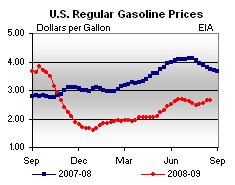The price of oil is rising once again. Demand is increasing to record levels in China as the U.S. appetite for oil is growing again, too. Reserves are dropping as well. So crude oil is now selling at more than $73 a barrel, a record for all of 2009.
Moreover, since there has been little change in the way oil is produced, traded or regulated, there is no reason speculators cannot keep oil moving up to the record $147 a barrel that it hit in July of 2008, barely a year ago. In fact, some warn oil prices won’t stop there this time.
A troubling question immediately comes to mind: will the effects of such high oil prices once again send the world’s economies into even deeper recessions than they are currently in? The timing is terrible. Western economies are just now showing signs of recovering.
Next tough question: will these higher oil prices then plunge back down to the $40 a barrel they were in December of 2008 because economies have tanked as a result of the higher oil prices? It’s a vicious circle.
The latest run-up in oil prices is prompting a debate over the various economic theories that purport to explain its pricing. How U.S. regulators and politicians interpret these theories is key to establishing more effective policies than we have used in the past. Many critics of our lack of a coherent energy policy argue that we haven’t learned from previous mistakes; that we must now have an energy policy that takes back control of our economy and our security from hostile nations. (Click here for the history of U.S. energy policy and its ongoing failure to cut down on oil imports.)
One key aspect of such a policy is regulation of financial markets. And some of the same people who brought you the toxic asset-backed mortgage securities fiasco — at the heart of the last financial collapse — are determined to forestall regulation once again.
The U.S. Commodity Futures Trading Commission, which lightly oversees oil trading now, is studying the oil futures market and is due to issue a report on oil speculation. The markets in energy futures are now essentially unregulated as the result of a complicated series of political deals and decisions, some of which are linked to pressure from the infamous — and now long bankrupt — Enron Corporation, which tripled the price of electricity in California by illegally manipulating the market.
However, government economists under Republican administrations have previously embraced a “supply and demand” theory and done nothing to regulate Wall Street speculation in oil. The same type of philosophy that led to unregulated Wall Street financial trading in credit default swaps and mortgage backed bonds that were fraudulently promoted as AAA rated investments when they were actually junk bonds.
There is no question that speculationin oil futures is growing: fifteen times more oil is traded electronically every day than is actually bought by companies that will use it. Worse, the trading is increasing, as the debate rages over how much speculation increases our energy costs, if at all. The big money interests argue that the markets are functioning adequately; regulation is not needed.
This view that such speculation is harmless and commodity markets are functioning properly is seriously challenged by a new study from the Peterson Institute for International Economics, an independent Washington “think tank” that promotes global trade.
Mohsin S. Khan, a senior fellow at the Institute, looks at a variety of indicators and explanations and concludes that speculation in the oil market created an oil price bubble in the first half of 2008. Absent speculative activities, the oil price dictated by demand would probably have been in the $80 to $90 a barrel range.
In other words, we paid almost twice what we should have, which is one of the main reasons our consumer-based economy went into a deep recession, which we are still struggling with. People were spending so much money on energy that there was little left over for other purchases.
If, as Khan argues, speculation played a significant role in the 2008 bubble, then policies—such as those being considered by the Commodity Futures Trading Commission—to limit oil futures positions will need action soon to prevent another bubble from emerging and then popping. Big money will be involved in this political fight.
Khan also says that another long-run danger for the world economy is that oil capacity expansion has slowed in 2009, but world oil demand is predicted to rise by about 0.6% a year from 2010 on, reaching 89 million barrels a day by 2014. (Current U.S. oil demand is 13.5 MBD.) If supply does not keep up and provide the additional barrels needed, a serious imbalance between future demand and supply in the world oil market would emerge. In sum, another economic catastrophe is in the making, as Congress is in recess.
We will have to wait and see what happens after Labor Day as the Senate and the House once again take up the Administration’s “National Fuel Efficiency Policy” and the various bills it has spawned, but haven’t we learned from our failures of policy in the past?
|
U.S. Retail Gasoline Prices |
|||
|
Retail Prices $ |
Change From Last |
||
|
08/17/09 |
Week |
Year |
|
|
2.637 |
-0.010 |
-1.103 |
|
|
2.652 |
0.027 |
-1.555 |
|
U.S. Average Gasoline Price Dips Slightly
Following three consecutive increases, the U.S. average price for regular gasoline slipped a penny to settle at $2.64 per gallon last week, according to the U.S. Energy Information Agency. The national average was $1.10 below the year-ago price. Regionally, prices dropped in the Midwest and on the Gulf Coast but increased elsewhere. On the East Coast, the average price moved up a cent to $2.62 per gallon. The price in the Midwest dropped the most of any region, falling nearly five cents to $2.55 per gallon. Remaining the lowest among the regions, the average price on the Gulf Coast slipped a penny to $2.51 per gallon. The Rocky Mountains had the largest increase of any region, increasing about four cents to $2.61 per gallon. The average on the West Coast and in California each inched up about a penny, to $2.96 and $3.05 per gallon, respectively.



Ken,
Seriously superior reporting on this topic. I am watching it from the perspective of the trucking industry (I edit, among other things, a newsletter for a trucking insurance company called the Roemer Report). Anyway, just wanted to let you know that you have a fan! Steve
Very timely.